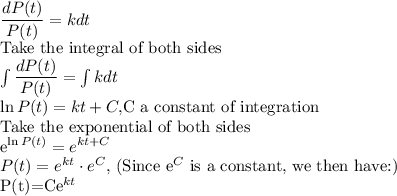
Mathematics, 07.07.2020 21:01 hoboethan
Let P(t) be a population at time t. A simple population model supposes the rate of growth of the population is proportional to the population (a) Express the last sentence in the language of calculus. (b) Solve for P(t) in the equation you found in part (a) (c) Suppose the net birthrate of the population is .1, and the initial population is 100. (i) Find the population at time t 10.(ii) Find when the population is 1000.

Answers: 1
Another question on Mathematics

Mathematics, 21.06.2019 21:50
What is the next step in the given proof? choose the most logical approach. a. statement: m 1 + m 2 + 2(m 3) = 180° reason: angle addition b. statement: m 1 + m 3 = m 2 + m 3 reason: transitive property of equality c. statement: m 1 = m 2 reason: subtraction property of equality d. statement: m 1 + m 2 = m 2 + m 3 reason: substitution property of equality e. statement: 2(m 1) = m 2 + m 3 reason: substitution property of equality
Answers: 3

Mathematics, 21.06.2019 22:00
(05.03 mc) part a: explain why the x-coordinates of the points where the graphs of the equations y = 4x and y = 2x−2 intersect are the solutions of the equation 4x = 2x−2. (4 points) part b: make tables to find the solution to 4x = 2x−2. take the integer values of x between −3 and 3. (4 points) part c: how can you solve the equation 4x = 2x−2 graphically? (2 points)
Answers: 1

Mathematics, 21.06.2019 23:30
Solve the equation: x - 9 = -6 + 5 a. 21 b. 7 c. 14 d. 2
Answers: 2

Mathematics, 22.06.2019 01:30
Im so bad at fractions they are not my best math thing to work on
Answers: 1
You know the right answer?
Let P(t) be a population at time t. A simple population model supposes the rate of growth of the pop...
Questions

English, 17.03.2020 03:28

Mathematics, 17.03.2020 03:28







Mathematics, 17.03.2020 03:28





Mathematics, 17.03.2020 03:29



Physics, 17.03.2020 03:29














